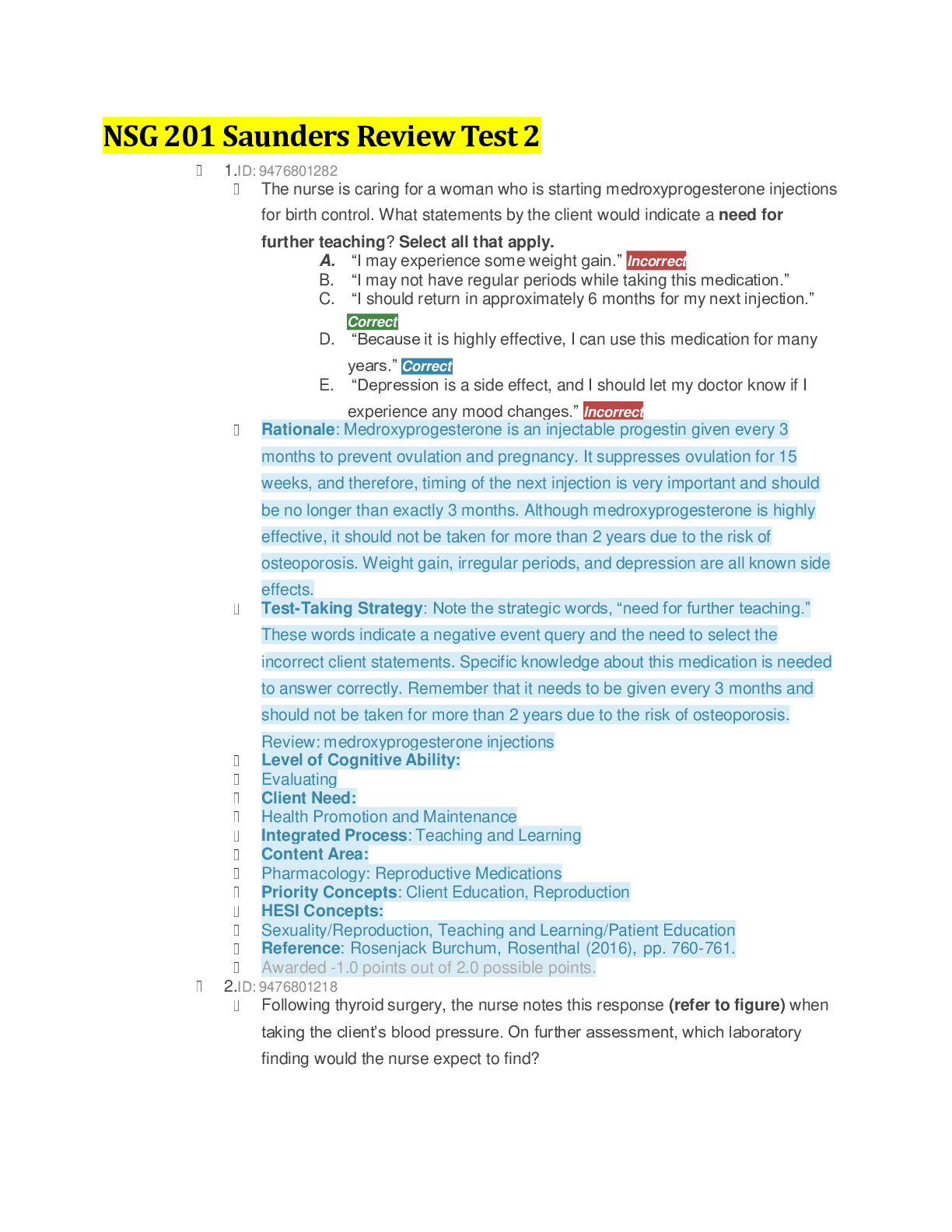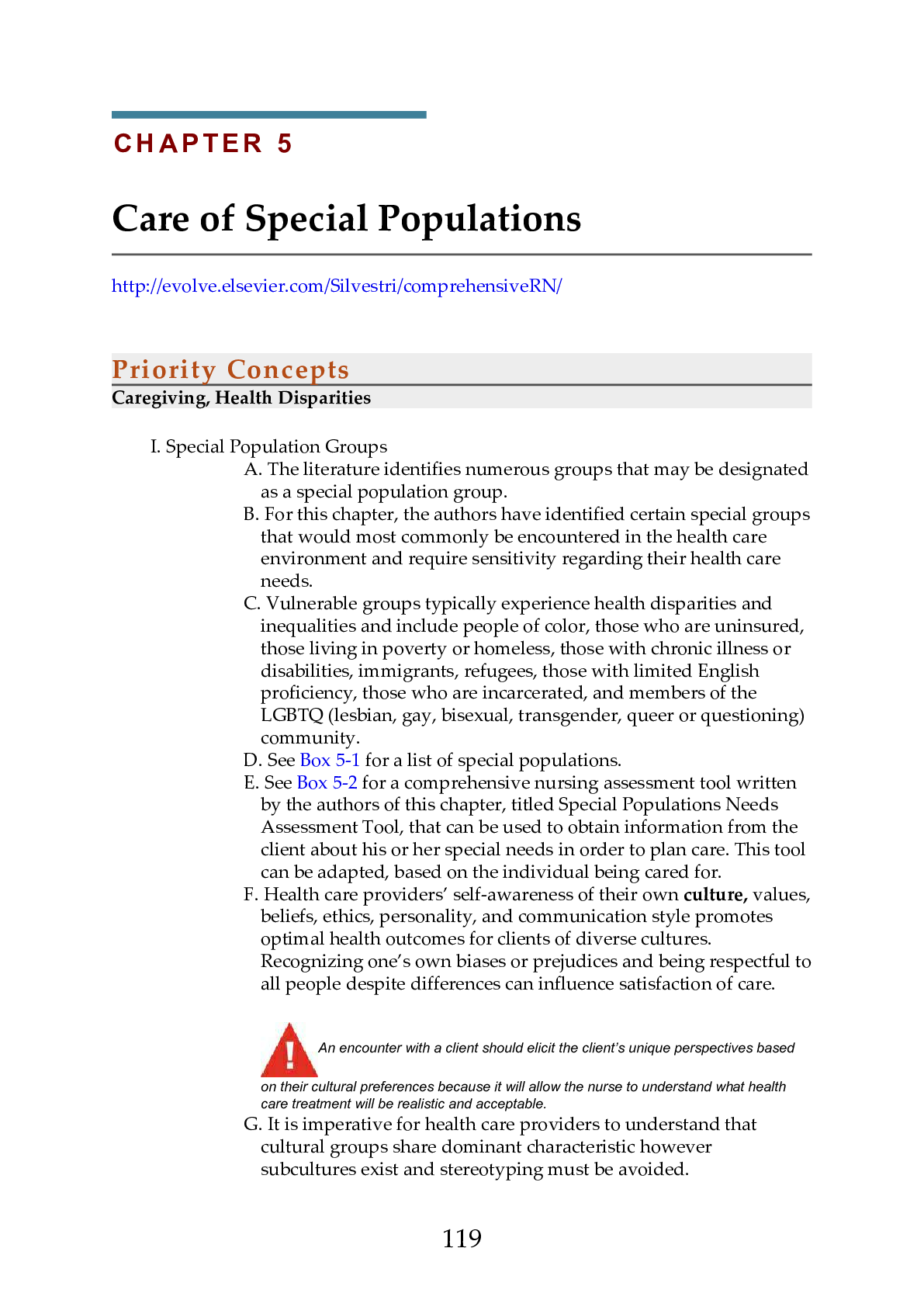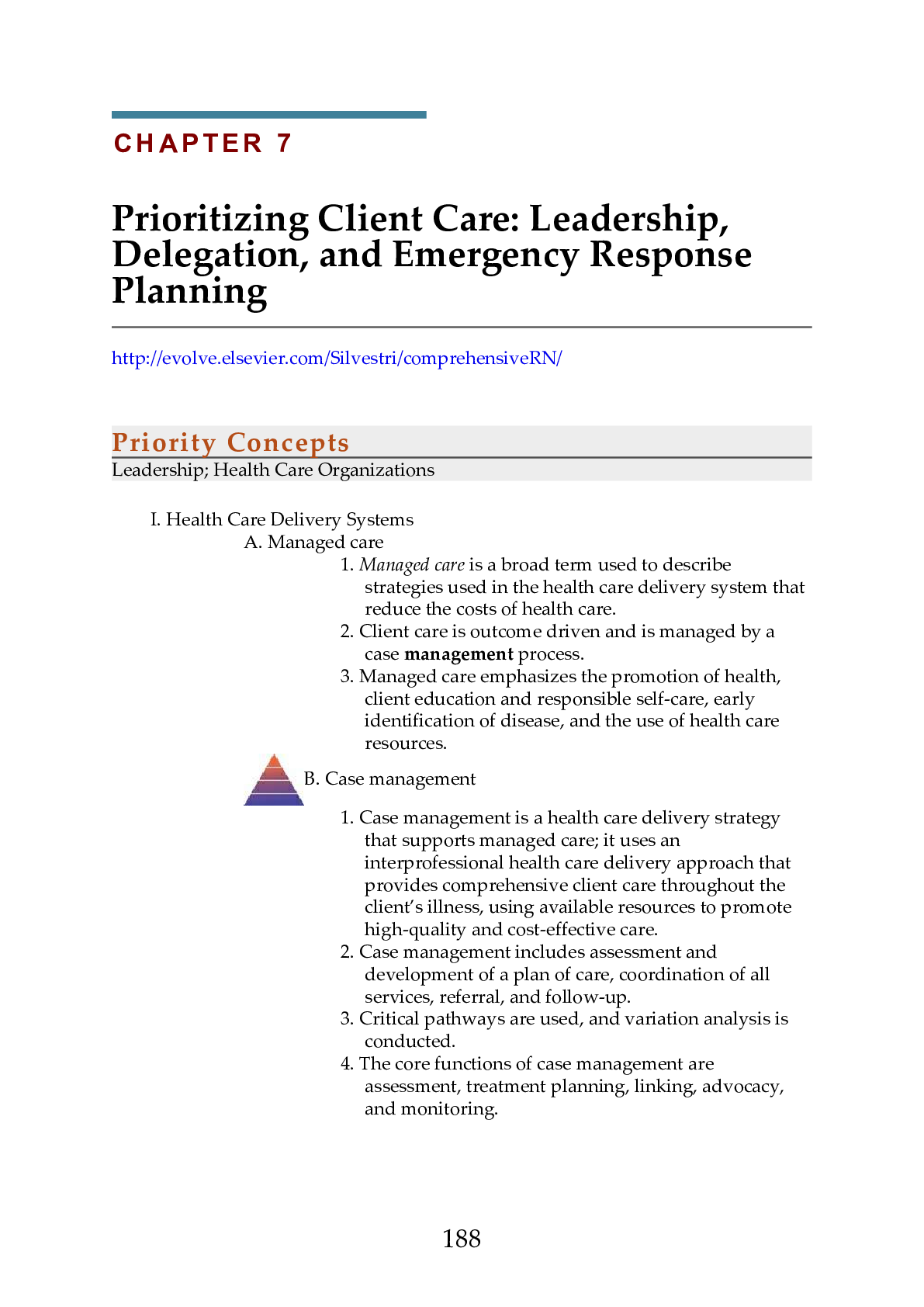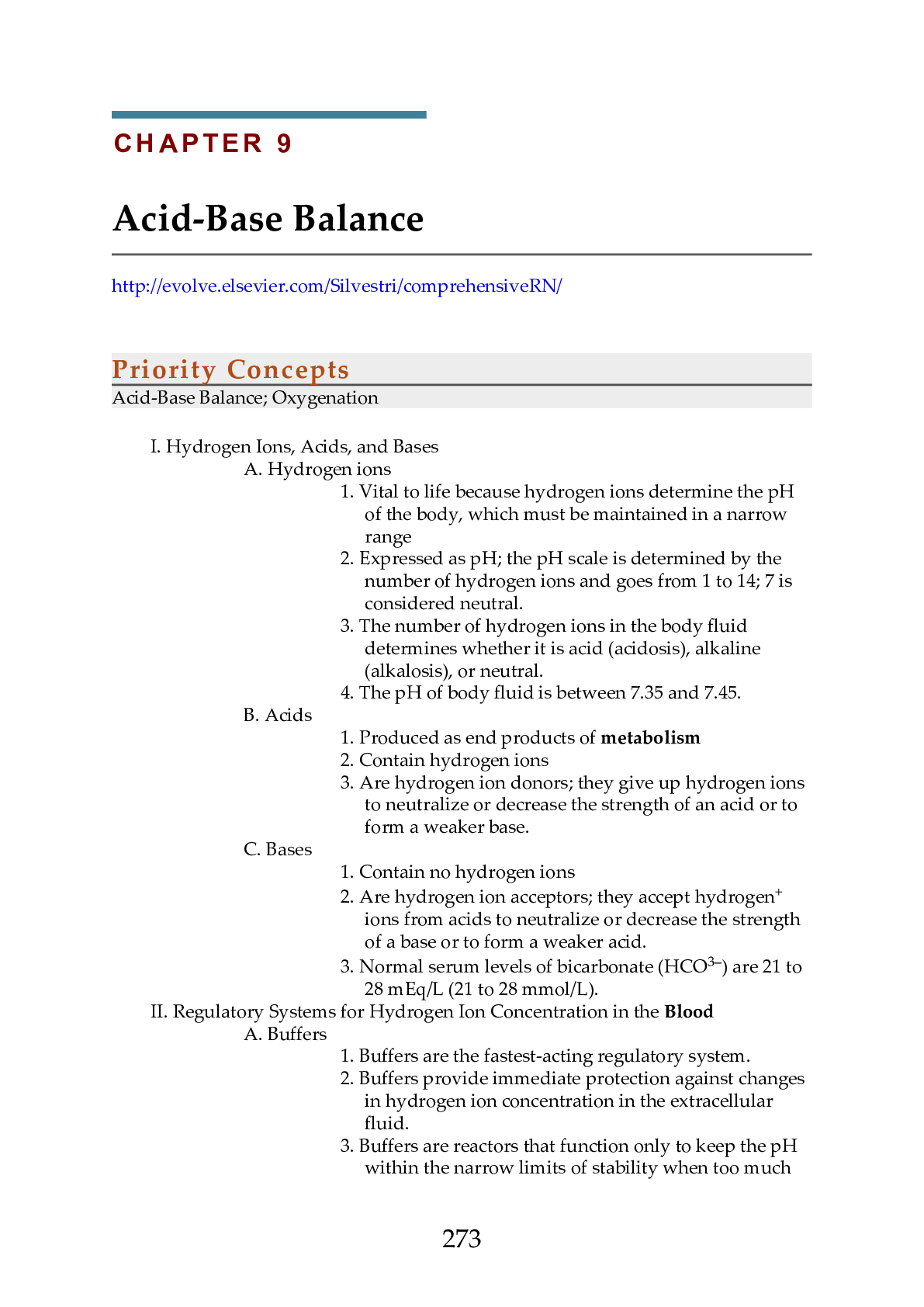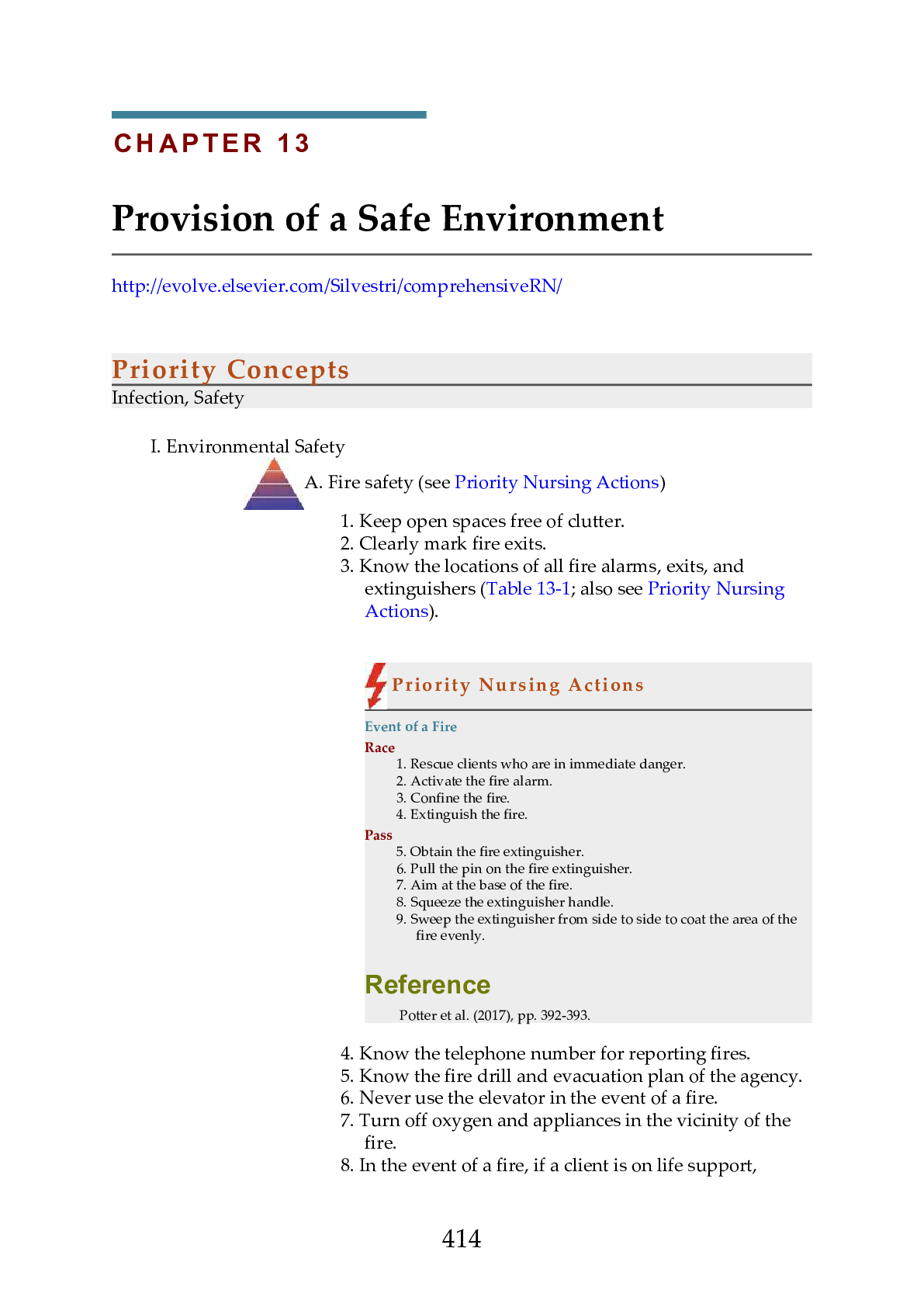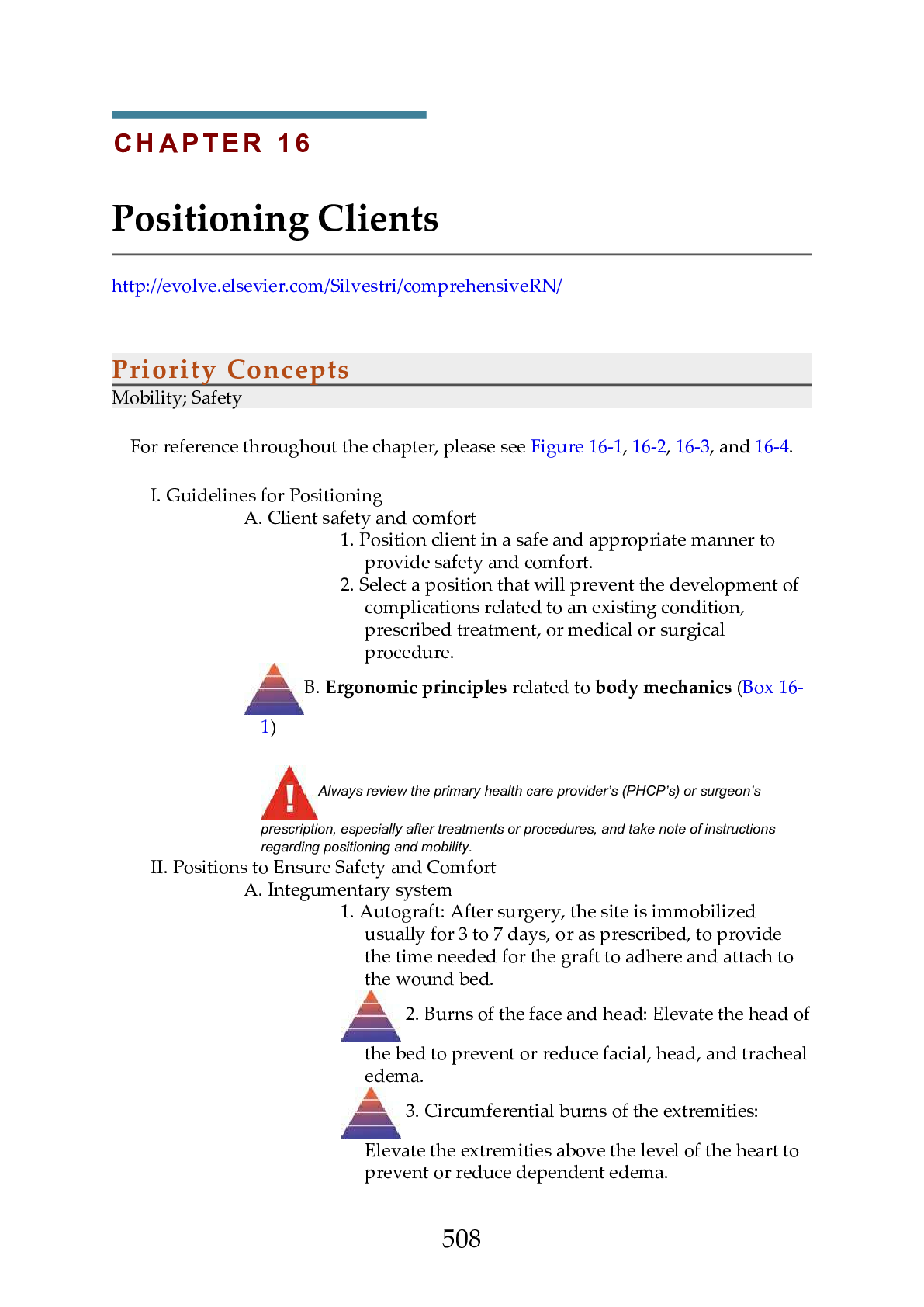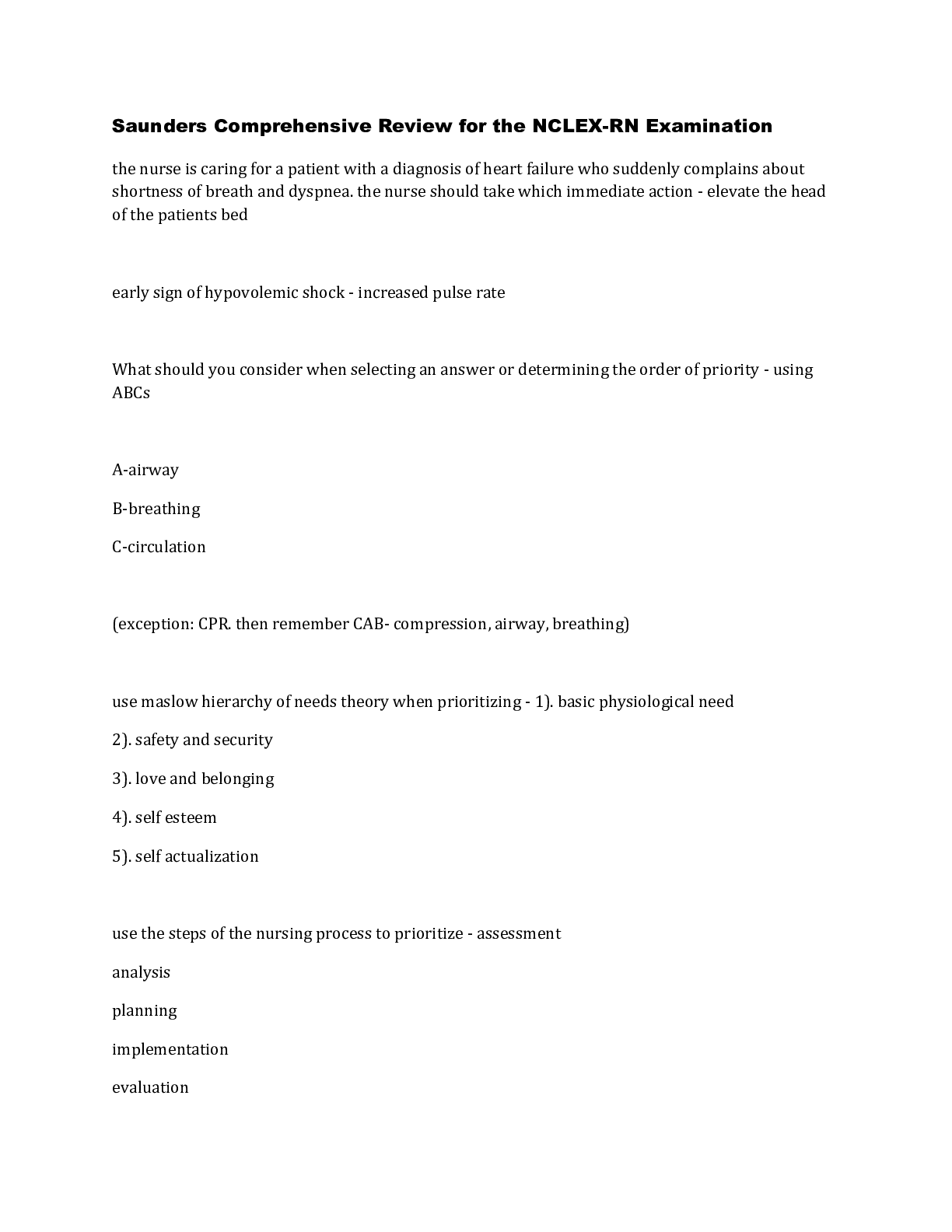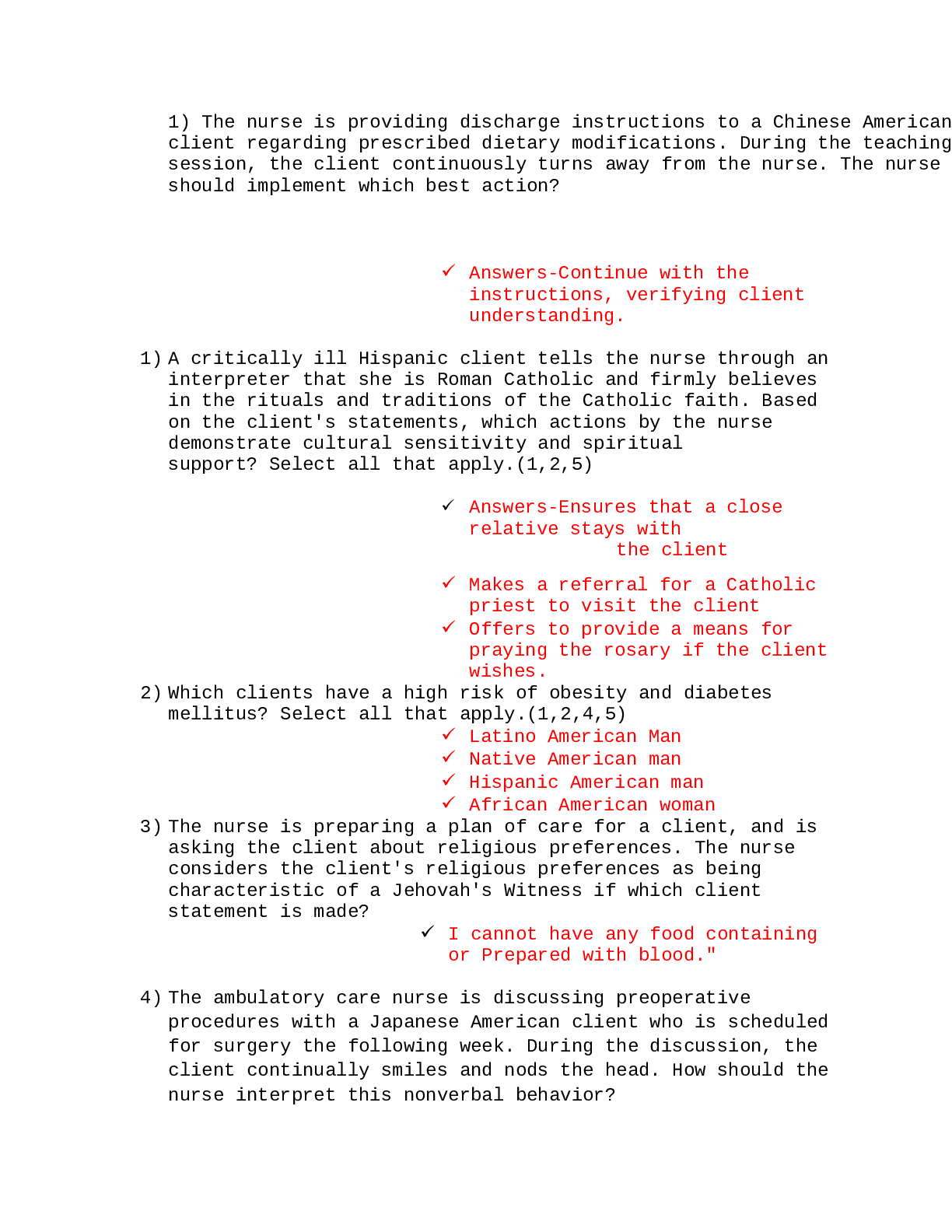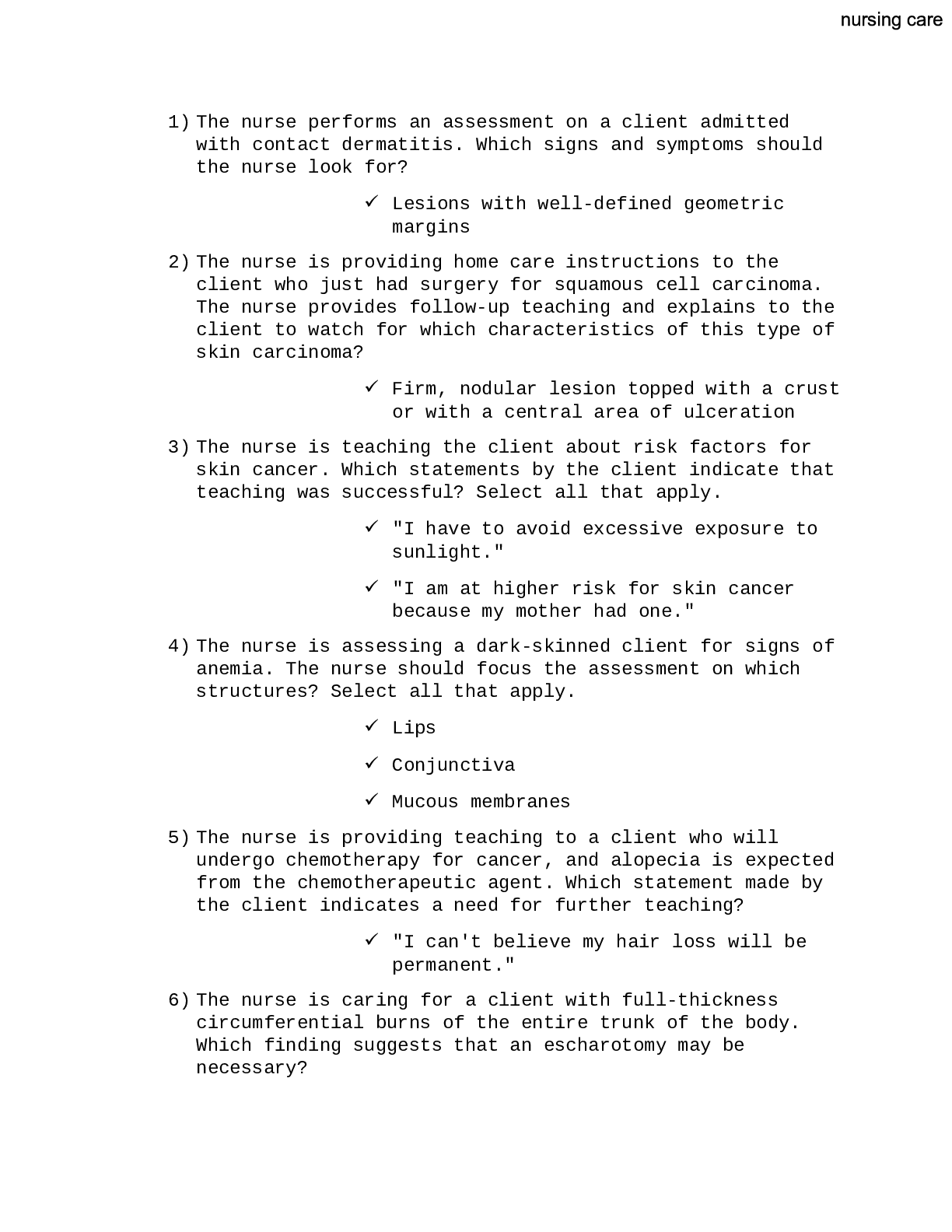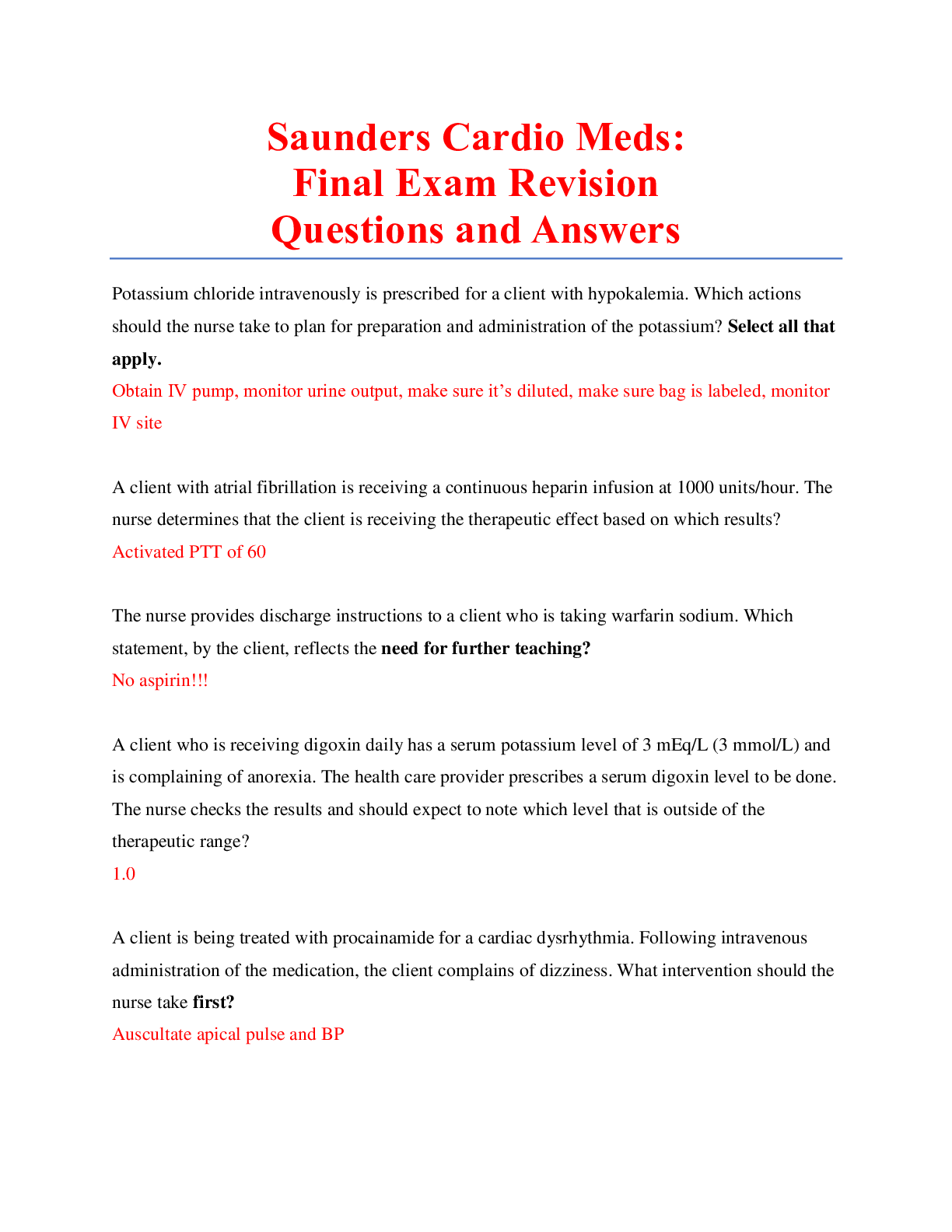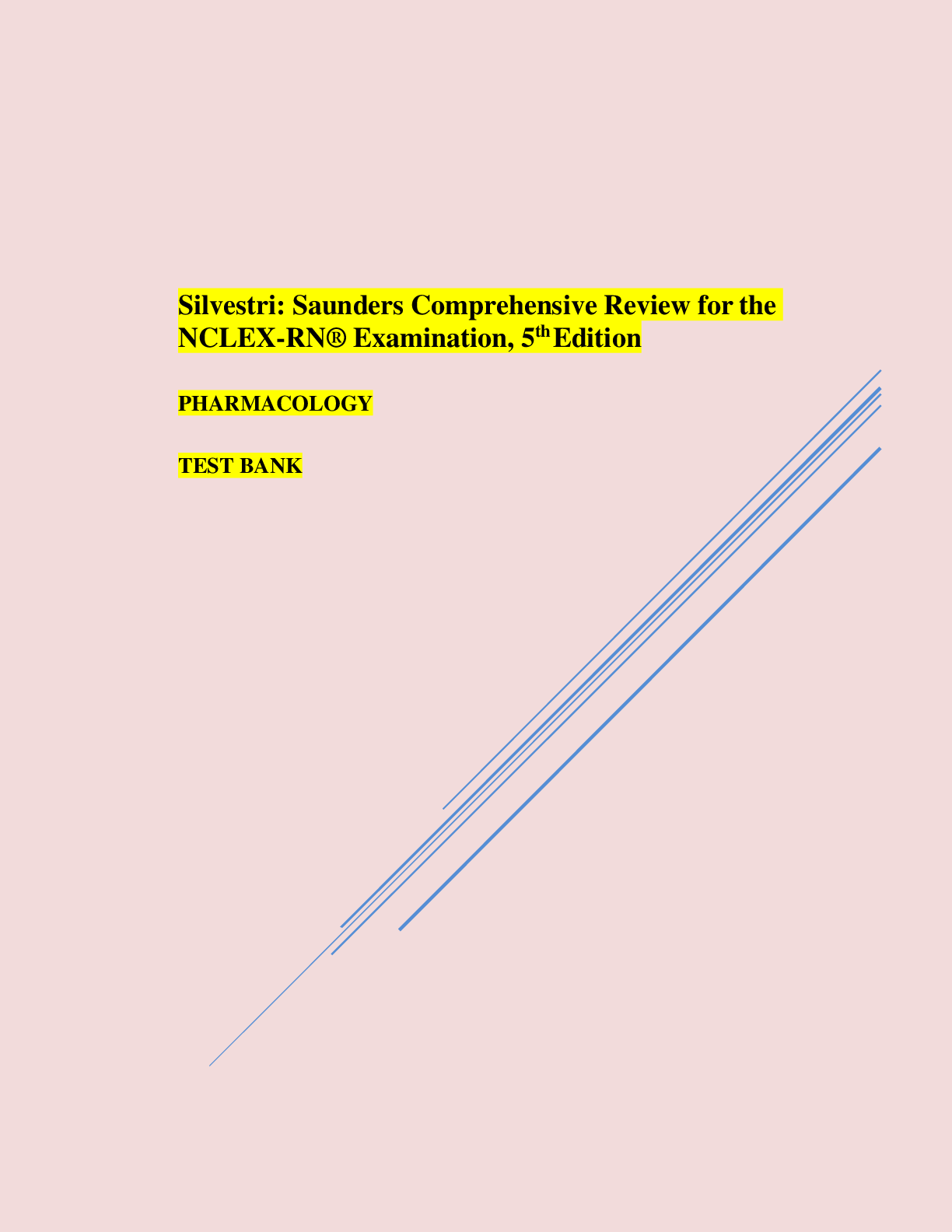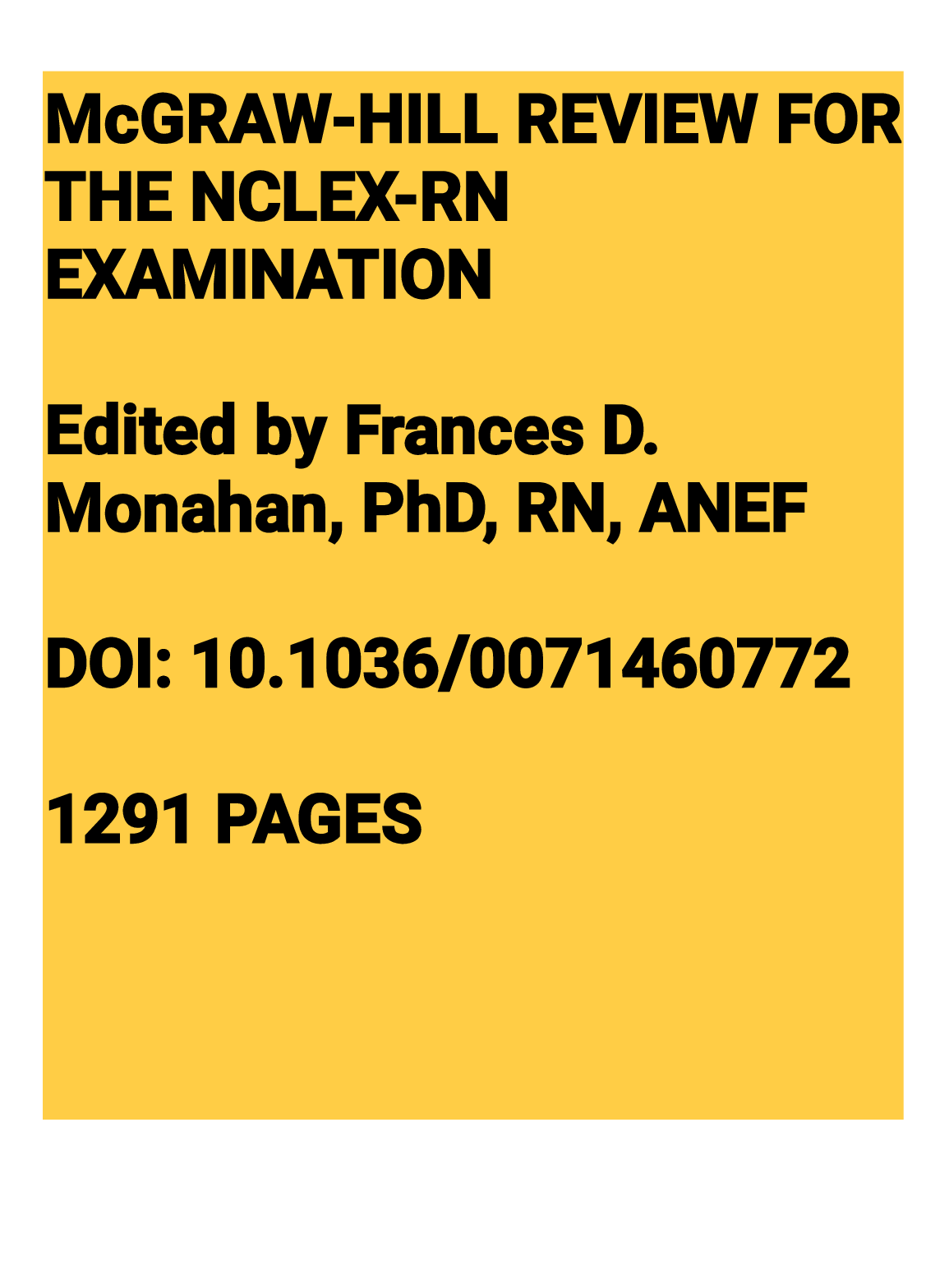*NURSING > NCLEX-RN > C H A P T E R 1 5 Perioperative Nursing Care: From Saunders Comprehensive Review for the NCLEX-RN Ex (All)
C H A P T E R 1 5 Perioperative Nursing Care: From Saunders Comprehensive Review for the NCLEX-RN Examination 8th Edition. (Available: https://bit.ly/2HeJuMt ). Contains Practice questions and Answers with the Rationale, Test-Taking Strategy, Level of Cognitive Ability, Client Needs, Integrated Process, Content Area, Health Problem, Priority Concepts and Referen
Document Content and Description Below
Priority Concepts Infection; Safety I. Preoperative Care A client may return home shortly after having a surgical procedure because many surgical procedures are done through ambulatory care or 1-d... ay stay surgical units. Perioperative care procedures apply even when the client returns home on the same day of the surgical procedure. A. Obtaining informed consent 1. The surgeon is responsible for explaining the surgical procedure to the client and answering the client’s questions. Often, the nurse is responsible for obtaining the client’s signature on the consent form for surgery, which indicates the client’s agreement to the procedure based on the surgeon’s explanation. 2. The nurse may witness the client’s signing of the consent form, but the nurse must be sure that the client has understood the surgeon’s explanation of the surgery. 3. The nurse needs to document the witnessing of the signing of the consent form after the client acknowledges understanding the procedure. 4. Minors (clients younger than 18 years) may need a parent or legal guardian to sign the consent form. 5. Clients who are not alert or oriented may need power of attorney or legal guardian to sign the consent form. 6. Psychiatric clients have a right to refuse treatment until a court has legally determined that they are unable to make decisions for themselves. 7. No sedation should be administered to the client before the client signs the consent form. 8. Obtaining telephone consent from a legal guardian or power of attorney for health care is an acceptable practice if clients are unable to give consent 472themselves. The nurse must engage another nurse as a witness to the consent given over the telephone. B. Nutrition 1. Review the surgeon’s prescriptions regarding the NPO (nothing by mouth) status before surgery. 2. Withhold solid foods and liquids as prescribed to avoid aspiration, usually for 6 to 8 hours before general anesthesia and for approximately 3 hours before surgery with local anesthesia (as prescribed). 3. Insert an intravenous (IV) line and administer IV fluids, if prescribed; per agency policy, the IV catheter size should be large enough to administer blood products if they are required. C. Elimination 1. If the client is to have intestinal or abdominal surgery, per surgeon’s preference, an enema, laxative, or both may be prescribed for the day or night before surgery. 2. The client should void immediately before surgery. 3. Insert an indwelling urinary catheter, if prescribed; urinary catheter collection bags should be emptied immediately before surgery, and the nurse should document the amount and characteristics of the urine. D. Surgical site 1. Clean the surgical site with a mild antiseptic or antibacterial soap on the night before surgery, as prescribed. 2. Shave the operative site, as prescribed; shaving may be done in the operative area. Hair on the head or face (including the eyebrows) should be shaved only if prescribed. E. Preoperative client teaching 1. Inform the client about what to expect postoperatively. 2. Inform the client to notify the nurse if the client experiences any pain postoperatively and that pain medication will be prescribed and given as the client requests. The client should be informed that some degree of pain should be expected and is normal. 3. Inform the client that requesting an opioid after surgery will not make the client a drug addict. 4. Demonstrate the use of a patient-controlled analgesia (PCA) pump if prescribed and explain that the client is the sole person who should push the button to 473administer medication. 5. Instruct the client how to use noninvasive pain relief techniques such as relaxation, distraction techniques, and guided imagery before the pain occurs and as soon as the pain is noticed. 6. The nurse should instruct the client not to smoke (for at least 24 hours before surgery); discuss smoking cessation treatments and programs. 7. Instruct the client in deep-breathing and coughing techniques, use of incentive spirometry, and the importance of performing the techniques postoperatively to prevent the development of pneumonia and atelectasis (Box 15-1). 8. Instruct the client in leg and foot exercises and the purpose of sequential compression devices to prevent venous stasis of blood and to facilitate venous blood return (Fig. 15-1; see Box 15-1; see Fig. 15-3). 9. Instruct the client in how to splint an incision, turn, and reposition (Fig. 15-2; see Box 15-1). 10. Inform the client of any invasive devices that may be needed after surgery, such as a nasogastric tube, drain, urinary catheter, epidural catheter, or IV or subclavian lines. 11. Instruct the client not to pull on any of the invasive devices; they will be removed as soon as possible. F. Psychosocial preparation 1. Be alert to the client’s level of anxiety. 2. Answer any questions or concerns that the client may have regarding surgery. 3. Allow time for privacy for the client to prepare psychologically for surgery. 4. Provide support and assistance as needed. 5. Take cultural and spiritual aspects into consideration when providing care (Box 15-2). G. Preoperative checklist 1. Ensure that the client is wearing an identification bracelet. 2. Assess for allergies, including an allergy to latex (see Chapter 62 for information on latex allergy). 3. Review the preoperative checklist to be sure that each item is addressed before the client is transported to surgery. 4. Follow agency policies regarding preoperative 474procedures, including informed consents, preoperative checklists, prescribed laboratory or radiological tests, and any other preoperative procedure. 5. Ensure that informed consent forms have been signed for the operative procedure, any blood transfusions, disposal of a limb, or surgical sterilization procedures. 6. Ensure that a history and physical examination have been completed and documented in the client’s record (Box 15-3). 7. Ensure that consultation requests have been completed and documented in the client’s record. 8. Ensure that prescribed laboratory results are documented in the client’s record. 9. Ensure that electrocardiogram and chest radiography reports are documented in the client’s record. 10. Ensure that a blood type, screen, and crossmatch are performed and documented in the client’s record within the established time frame per agency policy. 11. Remove jewelry, makeup, dentures, hairpins, nail polish (depending on agency procedures), glasses, and prostheses. 12. Document that valuables have been given to the client’s family members or locked in the hospital safe. 13. Document the last time that the client ate or drank. 14. Document that the client voided before surgery. 15. Document that the prescribed preoperative medications were given (Box 15-4). 16. Monitor and document the client’s vital signs. H. Preoperative medications 1. Prepare to administer preoperative medications as prescribed before surgery. 2. Instruct the client about the desired effects of the preoperative medication. After administering the preoperative medications, keep the client in bed with the side rails up (per agency policy). Place the call bell next to the client; instruct the client not to get out of bed and to call for assistance if needed. I. Arrival in the operating room 1. Guidelines to prevent wrong site and wrong procedure surgery a. The surgeon meets with the client in the preoperative area and uses a surgical marking pen to mark the operative site. 475b. In the operating room, the nurse and surgeon ensure and reconfirm that the operative site has been appropriately marked. c. Just before starting the surgical procedure, a time-out is conducted with all members of the operative team present to identify the correct client and appropriate surgical site again. 2. When the client arrives in the operating room, the operating room nurse will verify the identification bracelet with the client’s verbal response and will review the client’s chart. 3. The client’s record will be checked for completeness and reviewed for informed consent forms, history and physical examination, and allergic reaction information. 4. The surgeon’s prescriptions will be verified and implemented. 5. The IV line may be initiated at this time (or in the preoperative area), if prescribed. 6. The anesthesia team will administer the prescribed anesthesia. Verification of the client and the surgical operative site is critical. II. Postoperative Care A. Description 1. Postoperative care is the management of a client after surgery and includes care given during the immediate postoperative period as well as during the days after surgery. 2. The goal of postoperative care is to prevent complications, to promote healing of the surgical incision, and to return the client to a healthy state. B. Respiratory system Assess breath sounds; stridor, wheezing, or a crowing sound can indicate partial obstruction, bronchospasm, or laryngospasm, while crackles or rhonchi may indicate ateletasis, pneumonia, or pulmonary edema. 1. Monitor vital signs per agency policy. 2. Monitor airway patency and ensure adequate ventilation (prolonged mechanical ventilation during anesthesia may affect postoperative lung function). 3. Remember that extubated clients who are lethargic 476may not be able to maintain an airway. 4. Monitor for secretions; if the client is unable to clear the airway by coughing, suction the secretions from the client’s airway. 5. Observe chest movement for symmetry and the use of accessory muscles. 6. Monitor oxygen administration if prescribed. 7. Monitor pulse oximetry and end tidal carbon dioxide (CO2) as prescribed. 8. Encourage deep-breathing and coughing exercises as soon as possible after surgery. 9. Note the rate, depth, and quality of respirations; the respiratory rate should be greater than 10 and less than 30 breaths per minute. 10. Monitor for signs of respiratory distress, atelectasis, or other respiratory complications. C. Cardiovascular system 1. Monitor circulatory status, such as skin color, peripheral pulses, and capillary refill, and for the absence of edema, numbness, and tingling. 2. Monitor for bleeding. 3. Assess the pulse for rate and rhythm (a bounding pulse may indicate hypertension, fluid overload, or client anxiety). 4. Monitor for signs of hypertension and hypotension. 5. Monitor for cardiac dysrhythmias. 6. Monitor for signs of thrombophlebitis, particularly in clients who were in the lithotomy position during surgery. 7. Encourage the use of antiembolism stockings or sequential compression devices (Fig. 15-3), if prescribed, to promote venous return, strengthen muscle tone, and prevent pooling of blood in the extremities. D. Musculoskeletal system 1. Assess the client for movement of the extremities. 2. Review the surgeon’s prescriptions regarding client positioning or restrictions. 3. Encourage ambulation if prescribed; before ambulation, instruct the client to sit at the edge of the 477bed with his or her feet supported to assume balance. 4. Unless contraindicated, place the client in a low-Fowler’s position after surgery to increase the size of the thorax for lung expansion. 5. Avoid positioning the postoperative client in a supine position until pharyngeal reflexes have returned; if the client is comatose or semicomatose, position on the side (in addition, an oral airway may be needed). 6. If the client is unable to get out of bed, turn the client every 1 to 2 hours unless contraindicated. E. Neurological system 1. Assess level of consciousness. 2. Make frequent periodic attempts to awaken the client until the client fully awakens. 3. Orient the client to the environment. 4. Speak in a soft tone; filter out extraneous noises in the environment. 5. Maintain the client’s body temperature and prevent heat loss by providing the client with warm blankets and raising the room temperature as necessary. F. Temperature control 1. Monitor temperature. 2. Monitor for signs of hypothermia that may result from anesthesia, a cool operating room, or exposure of the skin and internal organs during surgery. 3. Apply warm blankets, continue oxygen, and administer medication as prescribed if the client experiences postoperative shivering. G. Integumentary system 1. Assess the surgical site, drains, and wound dressings (serous drainage may occur from an incision, but notify the surgeon if excessive bleeding occurs from the site). Mark time and date for any drainage on surgical dressings and monitor for excessive drainage per agency policy. 2. Assess the skin for redness, abrasions, or breakdown that may have resulted from surgical positioning. 3. Monitor body temperature and wound for signs of infection. 4. Maintain a dry, intact dressing. 5. Change dressings as prescribed, noting the amount of bleeding or drainage, odor, and intactness of sutures or staples; commonly used dressings include 4 × 4 478inch gauze, nonadherent pads, abdominal pads, gauze rolls, and split gauze that are commonly referred to as drain sponges. 6. Wound drains should be patent; prepare to assist with the removal of drains (as prescribed by the surgeon) when the drainage amount becomes insignificant. Empty drains as needed and document the output and drainage characteristics. 7. An abdominal binder may be prescribed for obese and debilitated individuals to prevent dehiscence of the incision. H. Fluid and electrolyte balance 1. Monitor IV fluid administration as prescribed. 2. Record intake and output. 3. Monitor for signs of fluid or electrolyte imbalances. I. Gastrointestinal system 1. Monitor intake and output and for nausea and vomiting. 2. Maintain patency of the nasogastric tube if present and monitor placement and drainage per agency procedure. 3. Monitor for abdominal distention. 4. Monitor for passage of flatus and return of bowel sounds. 5. Administer frequent oral care, at least every 2 hours. 6. Maintain the NPO status until the gag reflex and peristalsis return. 7. When oral fluids are permitted, start with ice chips and water. 8. Ensure that the client advances to clear liquids and then to a regular diet, as prescribed and as the client can tolerate. To prevent aspiration, turn the client to a side-lying position if vomiting occurs; have suctioning equipment available and ready to use. J. Renal system 1. Assess the bladder for distention. 2. Monitor urine output (urinary output should be at least 30 mL/hr). 4793. If the client does not have a urinary catheter, the client is expected to void within 6 to 8 hours postoperatively depending on the type of anesthesia administered; ensure that the amount is at least 200 mL. K. Pain management 1. Assess the type of anesthetic used and preoperative medication that the client received, and note whether the client received any pain medications in the postanesthesia period. 2. Assess for pain and inquire about the type and location of pain; ask the client to rate the degree of pain on a scale of 1 to 10, with 10 being the most severe. 3. If the client is unable to rate the pain using a numerical pain scale, use a descriptor scale that lists words that describe different levels of pain intensity, such as no pain, mild pain, moderate pain, and severe pain, or other available pain rating scales. 4. Monitor for objective data related to pain, such as facial expressions, body gestures, increased pulse rate, increased blood pressure, and increased respirations. 5. Inquire about the effectiveness of the last pain medication. 6. Assess respiratory rate, blood pressure, heart rate, oxygen saturation, and level of consciousness (LOC), and note if or when last medication was given prior to administering pain medication. Administer pain medication as prescribed. 7. Ensure that the client with a PCA pump understands how to use it. 8. If an opioid has been prescribed, after administration, assess the client every 30 minutes for respiratory rate and pain relief. 9. Use noninvasive measures to relieve postoperative pain, including provision of distraction, relaxation techniques, guided imagery, comfort measures, positioning, backrubs, heat or cold therapy, and a quiet and restful environment. 10. Document effectiveness of the pain medication and noninvasive pain relief measures. 480Consider cultural and spiritual practices and beliefs when planning pain management. III. Pneumonia and Atelectasis A. Description (Box 15-5 and Fig. 15-4) 1. Pneumonia: An inflammation of the alveoli caused by an infectious process that may develop 3 to 5 days postoperatively as a result of infection, aspiration, or immobility 2. Atelectasis: A collapsed or airless state of the lung that may be the result of airway obstruction caused by accumulated secretions or failure of the client to deep breathe or ambulate after surgery; a postoperative complication that usually occurs 1 to 2 days after surgery B. Assessment 1. Dyspnea and increased respiratory rate 2. Crackles over involved lung area 3. Elevated temperature 4. Productive cough and chest pain C. Interventions 1. Assess lung sounds. 2. Reposition the client every 1 to 2 hours. 3. Encourage the client to deep breathe, cough, and use the incentive spirometer as prescribed. 4. Provide chest physiotherapy and postural drainage, as prescribed. 5. Encourage fluid intake and early ambulation. 6. Use suction to clear secretions if the client is unable to cough. IV. Hypoxemia A. Description: An inadequate concentration of oxygen in arterial blood; in the postoperative client, hypoxemia can be due to shallow breathing from the effects of anesthesia or medications. B. Assessment 1. Restlessness 2. Dyspnea 3. Diaphoresis 4. Tachycardia 5. Hypertension 6. Cyanosis 7. Low pulse oximetry readings C. Interventions 1. Monitor for signs of hypoxemia. 481 Practice Questions 126. The nurse has just reassessed the condition of a postoperative client who was admitted 1 hour ago to the surgical unit. The nurse plans to monitor which parameter most carefully during the next hour? 1. Urinary output of 20 mL/hr 2. Temperature of 37.6° C (99.6° F) 3. Blood pressure of 100/70 mm Hg 4. Serous drainage on the surgical dressing 127. The nurse is teaching a client about coughing and deep-breathing techniques to prevent postoperative complications. Which statement is most appropriate for the nurse to make to the client at this time as it relates to these techniques? 1. “Use of an incentive spirometer will help prevent pneumonia.” 2. “Close monitoring of your oxygen saturation will detect hypoxemia.” 3. “Administration of intravenous fluids will prevent or treat fluid imbalance.” 4. “Early ambulation and administration of blood thinners will prevent pulmonary embolism.” 128. The nurse is creating a plan of care for a client scheduled for surgery. The nurse should include which activity in the nursing care plan for the client on the day of surgery? 4981. Avoid oral hygiene and rinsing with mouthwash. 2. Verify that the client has not eaten for the last 24 hours. 3. Have the client void immediately before going into surgery. 4. Report immediately any slight increase in blood pressure or pulse. 129. A client with a gastric ulcer is scheduled for surgery. The client cannot sign the operative consent form because of sedation from opioid analgesics that have been administered. The nurse should take which most appropriate action in the care of this client? 1. Obtain a court order for the surgery. 2. Have the charge nurse sign the informed consent immediately. 3. Send the client to surgery without the consent form being signed. 4. Obtain a telephone consent from a family member, following agency policy. 130. A preoperative client expresses anxiety to the nurse about upcoming surgery. Which response by the nurse is most likely to stimulate further discussion between the client and the nurse? 1. “If it’s any help, everyone is nervous before surgery.” 2. “I will be happy to explain the entire surgical procedure to you.” 3. “Can you share with me what you’ve been told about your surgery?” 4. “Let me tell you about the care you’ll receive after surgery and the amount of pain you can anticipate.” 131. The nurse is conducting preoperative teaching with a client about the use of an incentive spirometer. The nurse should include which piece of information in discussions with the client? 1. Inhale as rapidly as possible. 2. Keep a loose seal between the lips and the mouthpiece. 3. After maximum inspiration, hold the breath for 15 seconds and exhale. 4. The best results are achieved when sitting up or with the head of the bed elevated 45 to 90 degrees. 132. The nurse has conducted preoperative teaching for a client scheduled for surgery in 1 week. The client has a history of arthritis and has been taking acetylsalicylic acid. The nurse determines that the client needs additional teaching if the client makes which statement? 1. “Aspirin can cause bleeding after surgery.” 2. “Aspirin can cause my ability to clot blood to be abnormal.” 3. “I need to continue to take the aspirin until the day of surgery.” 4. “I need to check with my doctor about the need to stop the aspirin before the scheduled surgery.” 133. The nurse assesses a client’s surgical incision for signs of infection. Which finding by the nurse would be interpreted as a normal finding at the surgical site? 1. Red, hard skin 2. Serous drainage 3. Purulent drainage 4. Warm, tender skin 134. The nurse is monitoring the status of a postoperative client in the immediate 499postoperative period. The nurse would become most concerned with which sign that could indicate an evolving complication? 1. Increasing restlessness 2. A pulse of 86 beats per minute 3. Blood pressure of 110/70 mm Hg 4. Hypoactive bowel sounds in all 4 quadrants 135. A client who has had abdominal surgery complains of feeling as though “something gave way” in the incisional site. The nurse removes the dressing and notes the presence of a loop of bowel protruding through the incision. Which interventions should the nurse take? Select all that apply. 1. Contact the surgeon. 2. Instruct the client to remain quiet. 3. Prepare the client for wound closure. 4. Document the findings and actions taken. 5. Place a sterile saline dressing and ice packs over the wound. 6. Place the client in a supine position without a pillow under the head. 136. A client who has undergone preadmission testing has had blood drawn for serum laboratory studies, including a complete blood count, coagulation studies, and electrolytes and creatinine levels. Which laboratory result should be reported to the surgeon’s office by the nurse, knowing that it could cause surgery to be postponed? 1. Hemoglobin, 8.0 g/dL (80 mmol/L) 2. Sodium, 145 mEq/L (145 mmol/L) 3. Serum creatinine, 0.8 mg/dL (70.6 mcmol/L) 4. Platelets, 210,000 cells/mm3 (210 × 109/L) 137. The nurse receives a telephone call from the postanesthesia care unit stating that a client is being transferred to the surgical unit. The nurse plans to take which action first on arrival of the client? 1. Assess the patency of the airway. 2. Check tubes or drains for patency. 3. Check the dressing to assess for bleeding. 4. Assess the vital signs to compare with preoperative measurements. 138. The nurse is reviewing a surgeon’s prescription sheet for a preoperative client that states that the client must be nothing by mouth (NPO) after midnight. The nurse should call the surgeon to clarify that which medication should be given to the client and not withheld? 1. Prednisone 2. Ferrous sulfate 3. Cyclobenzaprine 4. Conjugated estrog [Show More]
Last updated: 1 year ago
Preview 1 out of 36 pages

Reviews( 0 )
Document information
Connected school, study & course
About the document
Uploaded On
Oct 22, 2020
Number of pages
36
Written in
Additional information
This document has been written for:
Uploaded
Oct 22, 2020
Downloads
0
Views
67


